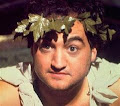Review: Under the Volcano (1984)
>> Friday, December 28, 2007

 USA-Mexico/C-112m./Dir: John Huston/Wr: Guy Gallo/Cast: Albert Finney (Geoffrey Firmin), Jacqueline Bisset (Yvonne Firmin), Anthony Andrews (Hugh Firmin), Ignacio Lopez Tarzo (Dr. Vigil), Rene Ruiz 'Tun-Tun' (Dwarf)
USA-Mexico/C-112m./Dir: John Huston/Wr: Guy Gallo/Cast: Albert Finney (Geoffrey Firmin), Jacqueline Bisset (Yvonne Firmin), Anthony Andrews (Hugh Firmin), Ignacio Lopez Tarzo (Dr. Vigil), Rene Ruiz 'Tun-Tun' (Dwarf)
The specter of death hangs over Geoffrey Firmin (Albert Finney), an ex-British consul staggering through the Day of the Dead festival in a small Mexican town in 1938. Although he has given up his government post, Firmin prefers to remain in Mexico, drinking himself to death over his separation from his wife Yvonne (Jacqueline Bisset), who he adores more than life itself. When Yvonne returns Mexico, she finds Geoffrey in the latter stages of alcoholism--more clear-headed when drunk than when sober--but she still holds out hope of mending their broken marriage. However, her past infidelity with Geoffrey’s brother (Anthony Andrews) stands as an obstacle between them.
John Huston’s adaptation of Malcolm Lowry’s novel is a strange mix of the old and new. The themes of alcoholism, sex, and death found in Under the Volcano are more complex and adult than those in Huston’s classic films. However, the direction and camerawork often seems rooted in methods used in the days of the studio system. This artificial technique often feels at odds with the realistic material. That said, the script and acting are excellent. While Bisset and Andrews turn in first-rate performances, this is really Finney’s show, and his Oscar-nominated portrayal of Geoffrey Firmin ranks with the greatest screen drunks of all time. From the opening frames to the bitter end, there is not a moment when Finney’s character is not inebriated to some extent, yet the performance is incredibly varied and nuanced. Although Firmin is a greatly depressed character, Finney manages to make him warm, witty, and likeable--the twinkle is never far from his eye--even in his blackest moments. His performance manages to buoy the entire film, keeping it from submerging beneath maudlin sentiment.
While Bisset and Andrews turn in first-rate performances, this is really Finney’s show, and his Oscar-nominated portrayal of Geoffrey Firmin ranks with the greatest screen drunks of all time. From the opening frames to the bitter end, there is not a moment when Finney’s character is not inebriated to some extent, yet the performance is incredibly varied and nuanced. Although Firmin is a greatly depressed character, Finney manages to make him warm, witty, and likeable--the twinkle is never far from his eye--even in his blackest moments. His performance manages to buoy the entire film, keeping it from submerging beneath maudlin sentiment.
While not without its flaws, Under the Volcano is essential viewing for soused cinema enthusiasts. Like Leaving Las Vegas (1995), it’s not as depressing as it sounds. In fact, the two films would make an excellent double feature.
Drinks Consumed--Tequila, mescal, brandy, whiskey, anis, champagne, gin, and colone
Intoxicating Effects--Staggering, stumbling, slurred speech, sneaking sips, delirium tremens, memory blackouts, the shakes, public disturbance, brawling, and physical violence
Potent Quotables--HUGH: Geoff, what possesses you?
GEOFFREY: Sobriety, I’m afraid. Too much moderation. I need drink desperately--get my balance back.
Video Availability--Under the Volcano DVD (Criterion)
Similarly Sauced Cinema--John Huston directed Richard Burton in The Night of the Iguana (1964), another film about a drunk in Mexico nearing the end of his rope.
































































